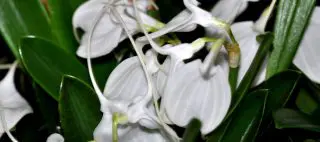4 tips so that it also succeeds
Orchids are one of the easiest houseplants to grow, but for many people they remain a mystery.
In this post I will give you 4 tips with which orchid care is almost foolproof….
Contents
Orchid Care – Understand Your Plant
Why do so many people have trouble caring for orchids? I think the reason is that orchids are different than other houseplants, and if you treat them like normal houseplants, they will soon die.
If you learn to understand orchids and treat them differently accordingly, they will thrive.
The most commonly sold orchids are the moth orchids or Phalaenopsis orchids. Since the Phalaenopsis orchid is a little hard to pronounce, most orchid lovers call them “Phals”.
This orchid is a great houseplant. It requires little care and blooms 6 to 12 months a year. No other houseplant can compete with orchids for blooming power.
Orchids are native to jungles in warm climates. They like humidity, warmth and an adequate amount of light. They like more light than most other houseplants, but they can get sunburned very easily if you expose them to too much direct sun.
The most important thing to know about orchids is that they grow slowly compared to other houseplants. Orchid growth can stall for months and look like nothing is happening… That’s why it’s important to match your care to the orchid’s growth rate.
Tip 1:
Get your orchids to bloom by cutting them back.
Butterfly orchids (Phalaenopsis) are one of the most popular houseplants in the world, can be made to bloom again with a very simple procedure. Especially under the faded shoots of this species are “dormant” buds. As soon as the last flower on the stem has faded, the shoot should be cut off with clean scissors just above the bud, these are very easy to recognize by the slight thickening.
After about three months, a new shoot often forms from this dormant bud. To prevent the shoot from becoming too long, cut the stem about halfway up, just above the second or third bud. Then place the butterfly orchid, also called moth orchid, in a cooler place.
In the dormant phase that now follows, the orchid needs little water and can also manage with less light.
Tip 2:
Optimal location for your orchids.
In general, orchids need a lot of light to bloom. In dark places, neither growth nor flower formation is possible.
During the winter months, early spring and late fall, a south-facing window is recommended for most orchids.
In the sunny months – from April to mid-September, adequate shade should be provided during the day and the plants should be placed about 40 cm from a window with direct sunlight – otherwise sunburn may occur.
For Phalaenopsis, a south-facing window can speed up the blooming period by two to three months.
Many cattleya and vanda orchids, for example, can bloom twice a year in a bright bathroom window with high humidity.
Tip 3:
How to get orchids to bloom with a cold stimulus.
If your orchids don’t want to bloom anymore, it may not only be due to a lack of light, but also due to an incorrect ambient temperature.
Moth orchids, for example, are heat-loving orchids and feel comfortable at temperatures of 20 to 25 degrees Celsius and high humidity during the day. To encourage particularly lazy orchids to bloom, you can temporarily move the plant to a cooler room, such as a bedroom or guest room. After two months at a temperature of 15 to 16 degrees Celsius, new flower buds should appear.
Unlike most orchids, cymbidium orchids, flowering time is mainly dependent on temperature. They absolutely need a cold stimulus during the flowering phase and must be kept at a temperature below 14 °C. Otherwise, the buds will fall off.
Tip 4:
Proper watering and fertilizing of orchids.
Proper watering is also important for the healthy and vigorous growth and successful flowering of orchids.
For watering, or better watering is best room-warm water with low lime content.
Here you can check in advance with a wooden stick whether there is still residual moisture in the substrate or whether watering is already necessary. Regular fertilization of orchids in low concentrations during the growth phase is also important for flowering.
If orchids are not fertilized sufficiently, growth stagnates and flowers fail to appear. Simply add one to two milliliters of liquid orchid fertilizer to the watering can every two weeks, depending on the species, to ensure optimal nutrient supply to the plants.
Remember to fertilize regularly during the growth phase – this keeps the orchids healthy and ensures abundant blooms.










